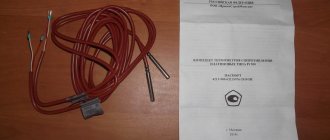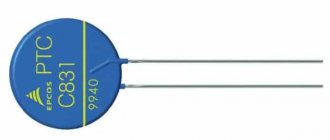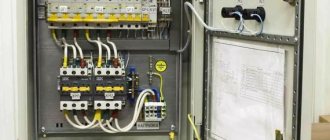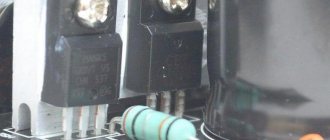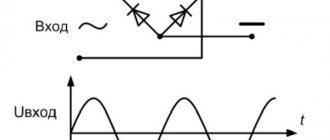Heating thermostat
About 30 years ago, special devices began to be used in the heating system, with the help of which it is possible to control the temperature conditions indoors. Heating thermostats - that’s what these devices are called. They have become an integral part of any heating system, regardless of the purpose of the room where it is used.
Using thermostats, you can not only regulate the flow and temperature of the coolant in heating radiators, but also, if necessary, completely shut off the flow to the radiator. This makes it easier to repair or replace the device, since there is no need to stop the entire heating process and completely drain the coolant. Therefore, installing a thermostat is a very profitable investment.
Without exception, all thermostats have the same design and the same operating principle. The only difference is the way the device is controlled.
Heating thermostat
A mechanical or, as it is also called, a manual heating thermostat has a temperature gradation on the valve. If you need to change the temperature inside the room, you just need to turn the handle in one direction or the other. Here it is important to accurately catch the required division. Sometimes this has to be determined empirically.
Types of thermostats
Electronic thermostats
- Conventional - the device sets the temperature parameters or its exact value that will be maintained. The device has an electronic display.
- Digital:
- With closed logic Such a device has a preset operating algorithm. The parameters are adjusted using special commands for pre-installed devices. The necessary parameters can be set depending on the temperature required for the device. In this case, the controller operating program itself cannot be changed. Most often, such thermostats are used in household appliances.
With open logic The device completely controls the heating process. In a thermostat with open logic, you can change the algorithm of its operation. The device is controlled using touch buttons. Using such a thermostat, you can set the heating of the room according to a specific schedule. Such thermostats are used for industrial purposes, and their reprogramming and installation of a new algorithm should be carried out by a specialist.
Advantages of electronic devices:
- Large temperature setting range;
- The accuracy is greater than that of mechanical ones;
- Efficiency;
- Not energy-consuming;
- Variety of designs.
Flaws:
- Dependent on stable electricity;
- They are affected by strong temperature changes.
Mechanical thermostats
Room thermostat for heating device
A room thermostat is an automatic device whose task is to regulate the temperature of a heating device. The device monitors the room air temperature and, if necessary, sends a signal to the boiler to increase or decrease its power. Typically, boilers are equipped with built-in programmers, but in some cases additional devices need to be connected separately.
Temperature regulator, remote
About the nuances of installation
The device is mounted at the top of the engine in the area where the coolant exits into the radiator unit. It helps to quickly warm up the vehicle, holding back cooling until the engine reaches an elevated temperature. The essence of the device lies in three elements: a cylinder, a pin, and wax. A scheme of this state has been used for a long time, without undergoing any special modernization, including in new brands of cars. As a result, engine parts do not wear out prematurely, and their dynamic performance improves.
Types of thermostats
Room thermostats are qualified by installation method, functionality, and technical design.
According to the installation method, they are distinguished:
- Wired thermostats, where contacts between blocks are maintained through wires. The advantage of such devices is the ability to transmit data to remote locations (further than 50 meters). The household electrical network is usually used as a power source.
- Wireless thermostats, where communications between the controller and the executive unit are carried out using periodic signals. The advantage of wireless technologies is that there is no need to make holes for wires. The main disadvantage: reinforced concrete walls greatly reduce the signal power and limit the working radius of the device.
Room thermostats for boilers do not create a harmful electromagnetic field, but only periodically transmit a low-power pulse. In addition to safety, this solution makes it possible to save battery power.
According to functionality, thermostats are classified into:
- simple ones that hold the desired temperature
- programmable, where it is possible to set the desired mode for a week in advance (accurate to the minute)
According to technical design, thermostats are divided into:
- electronic
- electromechanical
- mechanical
Appearance and modernization of the device
One of the first thermostats is considered to be the appearance of a mercury device for maintaining optimal temperature balance in a chicken incubator, which was invented in 1620 by Mr. Cornelius Drebbel from Great Britain.
The thermostat has been actively used in the liquid cooling system of internal combustion engines since 1922, when the first and relatively powerful units with large heat release during operation appeared. Early on, there were several unsuccessful attempts to use the device in a cooling system. Further, the design was improved, engineers selected optimal manufacturing materials and achieved such characteristics and reliability that the thermostat became a widely used element in the liquid cooling system of an internal combustion engine.
We also recommend reading the article about the design of a centrifugal pump for an internal combustion engine liquid cooling system. From this article you can learn about the design features of the pump, its functions in the cooling system, features of operation and repair of the pump.
There are two types of thermostats used in car cooling systems. There are solutions with solid or liquid filler. The gel thermostat for automobile liquid engine cooling systems was invented by a Frenchman named Serge Vernier in 1963. The Vernet company specializes in the production of thermostats today, and the products of this brand enjoy well-deserved authority in the auto parts market for various brands of cars around the world.
Thermostat filler
The thermostat can have various types of filler at the core of its design. We have already mentioned that there is a liquid filler and a solid filler. The operating principle and design of these solutions are almost the same. The differences lie only in the increased sealing of the liquid structure, as well as in the individual physical properties of the filler itself and its sensitivity to temperature fluctuations, depending on the composition.
Modern engines have received this type of device, which is based on a solid filler. By such a filler we mean the main thermoelement, which is initially in a solid physical state inside the thermostat.
Functions and location
Once the engine reaches its optimal operating temperature, it becomes necessary to maintain this indicator within strict limits until the very moment the engine stops, and in some cases, for some time after the engine stops operating. The main task of the device is to control and distribute the flow of heated cooling liquid inside the system to remove heat from the engine.
The thermostat can be located in different places, depending on the engine layout in the engine compartment, and the location of its installation directly depends on the model of the power unit. Also, the installation location of the device is influenced by the design features of the implementation of the cooling liquid system itself. In most cases, the thermostat is located where the coolant exits the cylinder head. The second most common location for its installation is the inlet of the centrifugal coolant pump (pump).
Let's take a closer look at the technical design
Electronic thermostats
An electronic room thermostat is based on three main components:
- temperature sensor
- signal transmitter
- thermostat
The main advantage of electronic thermostats is the accuracy of their work in identifying and adjusting the temperature regime in the room. This device is easy to control and can be used as part of a “smart home”.
Electromechanical thermostats
An electromechanical room thermostat is simpler in internal structure than an electronic one. The central element of the devices is the relay. This unit looks like a cylinder in the form of a tube, which is filled with a temperature-responsive substance. As soon as the boiler heats up, the substance expands. And vice versa: as the temperature decreases, the substance contracts. The drive reacts to changes in the substance and regulates the temperature using an electrical circuit.
Electromechanical thermostat
Mechanical thermostats
Mechanical type regulators are characterized by the absence of electronic filling. The operating principle of such thermostats is based on the ability of materials to change their properties under the influence of temperature. As a result of a change in the temperature regime of the substance in the gas membrane, the electrical circuit is closed or broken, which activates certain mechanisms of the equipment.
A room thermostat for a gas boiler (or any other) can be controlled mechanically or automatically. The degree of heating of the room is directly influenced by the temperature of the coolant. As soon as it heats up to the desired condition, the boiler turns off. When the temperature drops, it connects again. The response threshold differs in different systems, but in general it is 0.25 degrees.
The function of monitoring the operation of heating equipment is performed by the programmer. This device, in addition to the obvious convenience of automating the process, also performs another role - it allows you to save fuel. Indeed, in manual mode, the boiler often turns on and off, and the movement of the coolant is created by a pump that operates even when the heating system is turned off. The consequence of this is increased electricity consumption and reduced equipment life.
Note! The room thermostat responds not to the temperature of the coolant, but rather to the air temperature, as a result of which the number of boiler on-offs is reduced in comparison with manual adjustment. In other words, even if the batteries are already cold, but the air temperature in the room is at an acceptable level, the boiler will not turn on.
The boiler will also not turn on in some other situations:
- heating the room by the sun's rays
- decrease in temperature delta
- increase in the number of people in the room, etc.
The practice of using thermostats shows that they can save up to a third of thermal energy.
How to check the thermostat operation
To check the thermostat, you can use the following method: when changing the temperature setpoint, characteristic clicks should be heard when passing a temperature value equal to the ambient temperature - closing and opening of contacts.
If the thermostat is removable, then you can try to heat its sensitive element and check the operation.
If, for example, we consider the thermostat in the oven, then by setting a certain temperature, after warming up, you can observe the burner flame: if it decreases and remains at the same level, then everything is in order. The accuracy of the result obtained can be achieved using a thermometer.
You can use a thermometer or a multimeter with a thermocouple to ensure that the thermostat set point is operating correctly. This method is suitable, for example, for a washing machine. A tester will also help, which, when connected to the thermostat contacts, will show their closing and opening.
Tips for installing and connecting thermostats
Installers advise installing thermostats in living rooms. Their installation in a corridor or boiler room leads to system disorientation and false alarms. It is recommended to choose the coolest room or where there are the most people.
No heat sources such as radiators or heaters should be located near the thermostat. The device should not be exposed to direct sunlight. It is necessary to avoid placing the thermostat in a draft. It is also undesirable to be near electrical appliances that emit thermal noise.
The boiler is turned on and off by a special relay. The thermostat is connected using a terminal on the boiler at a specified location or via a thermostat cable. The programmer requires batteries to operate.
Before connecting the room thermostat, you need to read the instructions, which are located in the technical data sheet of the device. Usually the passport has a separate section dedicated to connecting the thermostat.
The main signs of a thermostat malfunction
Sometimes the thermostat device does not work properly.
The main signs that the thermostat has failed:
- If the device cools more than the desired temperature (the refrigerator begins to freeze);
- The device overheats (the car engine begins to boil);
- The lower pipe heats up very quickly (if it works properly, it takes a long time to heat up);
- When the engine is running, the displayed temperature drops sharply, and then rises back when turned off;
- The lower pipe does not heat up and remains cold. This happens if the device is closed for a long time, which leads to jamming of the structure
The reasons for the malfunction of the thermostat may be formed rust, jamming of the thermostatic valve in one of the positions: open or closed. If you do not remove dust from the device for a long time, it may become clogged and fail.
Diagnosis of failure, how to check without removing
There are several ways to check for a faulty device thermostat. This method is different in that it allows you to detect a breakdown without disassembling the device into parts. To determine whether the thermostat is working properly, you need to start the car engine for five to ten minutes. During this time, the hose going from the radiator to the thermostat should remain cold; if it heats up in such a short time, there is a problem with the design.
If you find any problems, it is best to contact a repair center, where they will help you solve the problem. You can only repair a device yourself if you know exactly how it works.
Now you know what a thermostat is, what a thermostat is used for, and what functions it performs. Devices are used in many areas of life: to automatically maintain the water temperature in the shower, to heat an oven or heater to a given temperature. After reading the article, you know what to do to detect a thermostat failure without disassembling the device. Depending on why a thermostat is needed in the device, different types are chosen.
Some tips when purchasing
If you decide to buy a mechanical, electronic or electromechanical room thermostat for the boiler, it is advisable to adhere to the following recommendations:
- It is worth choosing a thermostat from the same company that manufactured the boiler. This will ensure greater compatibility and easier installation.
- When purchasing a device, you should take into account the area of the room and the desired temperature conditions.
- To reduce heat loss, it is necessary to insulate the room
Educational program on thermostatic fillers
How does the filler affect functionality?
The serviceability of the unit is dictated by its qualitative properties and features.
- Liquid filler has not been used on Russian vehicles since 1983, so there is no point in writing about it.
- Models with wax content allow the “steel horse” to successfully cruise over different distances. They are suitable for products of the Russian and foreign automotive industry. The models are based on ceresin, a special wax. It is complemented by copper powder enclosed in a brass or copper cylinder. While the engine is running, the container heats up and the temperature of the wax increases. When the latter expands, the coolant comes into action. When the temperature drops, the wax returns to its original shape. This opens the spring and closes the passage in the thermostat. The fluid first flows in a smaller circle, then runs to the pump and into the coolant system. On VAZs, the operation of the thermostat has a number of features. Thus, the opening temperature of the thermostat on the Grant is the traditional 80-90 degrees.
Dismantling instructions
Before changing the thermostat, you must remove the previously installed device. To perform dismantling yourself, you must follow the instructions below:
- Drain the antifreeze;
- Remove the air filter;
- Unscrew the 2 bolts and the fastening nut;
- Remove the recirculation valve;
- Loosen the air hose leading to the mass air flow sensor. After this, move the meter itself;
- The connection diagram of the hoses to the thermostat may differ, but it is important to disconnect all pipes;
- Disconnect the electrical wire going to the thermostat. It is not present on all types of devices;
- Unscrew the stud and nut of the temperature sensor;
- The thermostat gasket may stick in the seat. It is necessary to remove the thermostat by slightly shaking it, as shown in the image below.
On different cars, the technology for replacing a thermostat may differ. It may be necessary to dismantle interfering components. Or, on the contrary, the car owner has access to the thermostat immediately after lifting the hood.
Features of thermostats on VAZ
These cars are equipped with a two-valve device containing wax contents. At the same time, the opening temperature of the Kalina thermostat is 90 0C. Before the engine heats up, the fluid has time to go through a small circle. The liquid then circulates to the pump part. At the same time, it passes through the intake “jacket”, the carburetor chamber for mixing. When the interior heating is turned on, the liquid also has to pass through the radiator.
What happens when the engine does not heat up properly? Partial opening of the main valve and incomplete closing of the second. As a result, a certain portion moves to the radiator. Such a mechanism will warm up the power unit faster. The valve will open completely when the opening temperature of the VAZ thermostat is 90 degrees.
Cost of parts and repairs
Most auto repair shops recommend replacing the thermostat every 3-5 years, without waiting for problems to arise. It is most convenient to do this together with diagnosing the cooling system or replacing the coolant. The cost of this work is low, it all depends on the position of the part under the hood and the car manufacturer.
The car market responds to demand with a wide range of both universal ones, designed for almost any engine, and individual copies. Domestic production will be an order of magnitude cheaper than imported analogues. For example, the cost of a Russian unit for a VAZ will be about 300 rubles. While a foreign device has a price of 600 rubles and above.
Replacement using the example of a Stinol refrigerator
For Stinol refrigerators, relay failure is a fairly common occurrence, especially after five to seven years of operation.
Most often, the bellows tube fails here, since this is the option provided by the manufacturer of this element. The Stinol-101 model has only one compressor, but the Stinol-103 has two: separately for the refrigeration and freezer compartments.
This is a contact diagram for a K-59 type thermal relay, which allows you to get an idea of which wires should be connected where. Color markings may vary; a photo on your phone will help you save the information; you can also draw a similar diagram yourself
The automation of different models is slightly different, which is reflected in the corresponding electrical diagrams, but otherwise these refrigerators are very similar, so it makes sense to consider the procedure for repairing them at the same time.
To understand that the Stinol refrigerator needs repair or replacement of the thermostat, you need to pay attention to the following signs:
- the compressor runs non-stop and does not respond when the regulator is set to OFF;
- when moving the adjustment knob to the OFF mark, there is no characteristic click;
- the temperature in the refrigerator chambers noticeably exceeds the parameters set during adjustment.
The Stinol-103 refrigeration chamber uses a K-59 thermal relay; it is easy to check the markings, they are indicated on the body. To remove the adjustment knobs, you need to use a thin awl. You just need to pry them up and remove them. The Stinol-101 model has only one adjustment knob, while the Stinol-103 has two, one for each compressor.
To remove the adjustment knob of the Stinol refrigerator (1), you need to use some sharp object, for example an awl. Then remove the decorative trim (2), which is held in place by four protrusions
After the handle is removed, you need to remove the decorative trim, which has six protrusions. This is a fragile item and must be handled with care to avoid damaging it. There are nuts under the cover that need to be unscrewed. After this, you need to unscrew the screws that secure the control panel.
Under the decorative trim there are mounting screws (1) that hold the thermal relay in the correct position; they must be unscrewed to continue dismantling the element
It is best to remove the screws holding the refrigerator door hinge last. To avoid possible damage, the door must be held. Now you can lift the panel and remove the door from its hinges.
The next step is to remove the top cover of the refrigerator.
The fasteners that secure the control panel and door hinge (1) of the Stinol refrigerator must be unscrewed, moving towards the door, and not away from it
The necessary fasteners are located on the rear side. They are unscrewed and the cover is removed. This will give you free access to the thermostat.
First you need to disconnect the relay contact connectors, after which you can remove the element from the refrigerator control panel.
After the doors and top panel of the Stinol refrigerator have been removed, you can carefully remove the thermal relay for inspection and diagnostics
At this stage, you need to remember or write down the color coding of the individual wires. To remove a worn capillary tube, remove the plastic cover.
Now you need to unscrew the fixing screw and remove the lighting unit. The tube is removed through the hole provided for this purpose.
To continue replacing the thermostat in the Stinol refrigerator, you need to remove the cover (1) in the refrigerator compartment and remove the capillary tube (2)
The new element is installed in such a way that the uninsulated area in its lower part is securely hidden under the overlay. The hole is closed with a plastic plug to restore the seal of the chamber.
Typically the capillary tube protrudes beyond the thermostat. It must be carefully placed under the top lid of the refrigerator; there is enough space there.
To remove the capillary tube (2) and replace it, you first need to disconnect the lighting unit, which is secured with a screw recessed into its housing
Now you need to reassemble the thermostat and the refrigerator: connect all the necessary connections, install and secure the refrigerator lid, and hang the door.
And again, screwing the door hinge fasteners is done last, when other similar screws are already installed.
The hole that appears on the rear panel during repair work should be sealed with plastic to restore the tightness of the refrigerator compartment
To check the condition of the Stinol refrigerator thermostat at home, you can use simple diagnostics. Contacts 3 and 4 of such a device should remain closed at room temperature.
If, after connecting them with a jumper, the compressor turns on, the thermal relay is faulty and needs to be replaced. If the thermostat settings are lost, they can be corrected by turning the adjusting screws, but this should be done in a service center that has the necessary equipment.
An equally important functional unit in the design of the refrigerator is the starting relay, the device, purpose and repair methods of which will be introduced in our recommended article.
Conclusions and useful video on the topic
The process of replacing the thermostat is clearly demonstrated in the following video, in which the master shares the nuances of repairing Stinol-type refrigeration equipment:
Interesting tips for diagnosing the condition of the relay and replacing it using the example of two models of refrigerators are contained in this video:
The procedure for replacing a thermostat cannot be called too complicated. However, if you mishandle this element, you can only worsen the situation. A detailed study of the repair procedure and attention to detail will help restore the functionality of the refrigerator .
Tell us about how you selected a thermostat to restore the functionality of the refrigerator. Share useful information and valuable information on the topic of the article that can be useful to site visitors. Please leave comments, post photos and ask questions in the block below.
Recommendations for use
Domestic cars often experience problems maintaining engine operating temperature. Moreover, this can occur even with a working thermostat. To solve this problem, experts recommend using different thermostats seasonally. For example, in winter, drive with the element at 85 degrees, and in summer - at 75. This way the car will warm up faster in winter and not boil in summer. Also, you will not experience problems with a cold stove.


